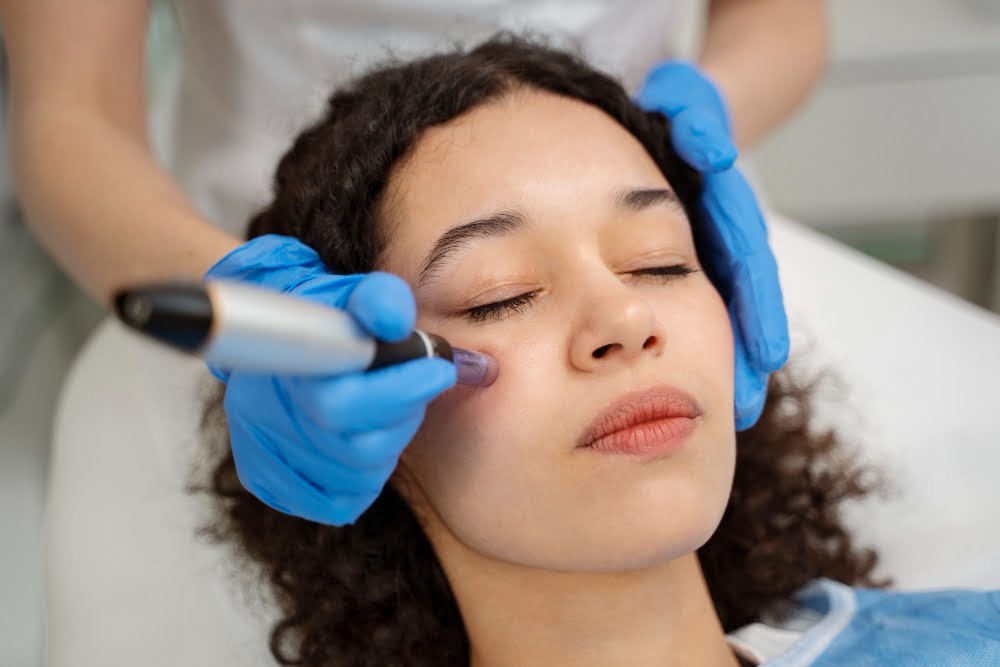FREE SHIPPING OVER $50
Radio Frequency Ruined My Face: Side Effects and Solutions
Radio frequency (RF) treatments have gained immense popularity in the realm of non-surgical skin tightening and rejuvenation. Promising to enhance elasticity, stimulate collagen production, and reduce the appearance of fine lines and wrinkles. These treatments seem like a miracle solution for aging skin. However, the reality is that RF treatments can sometimes lead to unintended and adverse effects, that could make an individual say “radio frequency ruined my face.” This article delves into the potential side effects of RF treatments and offers practical solutions for those experiencing these issues.
Key Takeaways:
Understanding Radio Frequency Skin Treatments

Radio frequency (RF) skin treatments use energy waves to heat the deeper layers of the skin to rejuvenate and tighten it non-invasively. The primary goal is to stimulate collagen production, a crucial protein that provides structure and elasticity to the skin.
How RF Treatments Work
Here’s a closer look at how RF treatments work and their interplay with microneedling:
- Mechanism of Action: RF treatments work by emitting energy waves that generate heat within the dermis, the second layer of the skin. This controlled heating process causes collagen fibers to contract and encourages the production of new collagen and elastin fibers. The result is tighter, firmer skin with a reduction in fine lines and wrinkles.
- RF Microneedling: Microneedling, which involves the use of fine needles to create micro-injuries in the skin, can be combined with RF technology to enhance the treatment’s effectiveness. This combination allows the RF energy to be delivered deeper into the skin through the microneedles. They target collagen production more effectively and treat issues such as scars, stretch marks, and overall skin texture.
- Treatment Types: RF treatments come in various forms, including monopolar, bipolar, and multipolar devices. Each of these deliver RF energy in different ways. Monopolar devices send energy deep into the skin. Bipolar and multipolar devices target more superficial layers, allowing for customization based on individual needs.
- Procedure: During an RF treatment, a handheld device is used to deliver RF energy to the skin. The procedure typically lasts between 30 to 60 minutes, depending on the area being treated. It’s generally well-tolerated, with patients experiencing a warm sensation as the device moves over their skin.
- Recovery and Results: Post-treatment, patients might experience mild redness and swelling. This usually subsides within a few hours to a couple of days. The full benefits of RF treatments, such as improved skin texture and tightness, are often visible after multiple sessions over several months as collagen remodeling takes place.
Personal Experiences with RF Treatments
Consider the experience of Jane, a 45-year-old woman who sought RF treatments to address signs of aging and achieve a more youthful appearance. Jane’s journey began with high hopes, driven by glowing reviews and impressive before-and-after photos she found online. She decided to undergo a series of RF microneedling sessions, combining the benefits of both technologies to maximize collagen stimulation and skin tightening.
During her initial consultation, Jane’s practitioner explained the importance of precise settings on the RF device to avoid adverse effects, such as unwanted fat loss or burns. Despite this, Jane experienced a few unexpected outcomes. In her case, the provider did not adequately adjust the depth and intensity of the microneedling combined with RF energy for her skin type and facial anatomy.
After her third session, Jane noticed significant changes. While the skin on her lower face appeared tighter, she observed a hollowed appearance around her cheeks and under her eyes. This unintended fat loss gave her face a gaunt look, far from the youthful fullness she desired. Additionally, the aggressive application of the RF device caused Jane to develop small areas of hyperpigmentation.
Jane’s experience underscores the importance of careful planning and professional expertise in RF treatments.
Potential Side Effects of Radio Frequency Treatments
While many people experience positive results from RF treatments, others may encounter a range of negative side effects. These can include:
- Skin Burns and Blisters: Improper use of RF devices can lead to skin burns and blisters. This often occurs when you leave the device in one spot for too long or use it at too high a temperature.
- Fat Loss: One of the most concerning side effects is unintended fat loss. RF treatments can sometimes target fat cells in addition to collagen. This leads to a hollow or gaunt appearance, in the facial area where volume is crucial for a youthful look.
- Skin Sagging: Paradoxically, while RF treatments are intended to tighten the skin, they can sometimes cause or exacerbate skin sagging. This can happen if the treatment weakens the skin’s structure or if fat loss occurs in areas that should remain plump.
- Hyperpigmentation: Some individuals may experience changes in skin pigmentation, with areas of hyperpigmentation (dark spots) developing after RF treatments.
- Scarring: In rare cases, RF treatments can cause scarring. This may happen if the treatment burns the skin or if there is an adverse reaction.
Why Do These Side Effects Occur?
The side effects of RF treatments often arise from improper use or overuse of the devices. For instance, using the device at too high a temperature or for too long can lead to burns and blisters. Similarly, using a device designed for professional settings at home, without the necessary expertise, can result in negative outcomes.
Additionally, individual skin types and conditions can influence the reaction to RF treatments. Those with sensitive skin or certain skin conditions may be more prone to adverse effects.
Solutions for Addressing Negative Side Effects
There are several steps you can take to address and mitigate the side effects of radio frequency:
- Consult a Dermatologist: The first and most crucial step is to consult with a dermatologist or skincare professional. They can assess the extent of the damage and recommend appropriate treatments.
- Topical Treatments: For burns and hyperpigmentation, topical treatments such as aloe vera, and brightening agents like vitamin C can help soothe the skin and reduce discoloration.
- Laser Treatments: For more severe hyperpigmentation or scarring, laser treatments can be effective. These treatments work by targeting the deeper layers of the skin to promote healing and even out skin tone.
- Dermal Fillers: If fat loss has caused a hollow appearance, dermal fillers can help restore volume. Inject fillers like hyaluronic acid into the affected areas to plump the skin and improve facial contours.
- Microneedling: Microneedling can help stimulate collagen production and improve the texture and appearance of the skin. This treatment involves using fine needles to create micro-injuries in the skin, which promote healing and rejuvenation.
- Platelet-Rich Plasma (PRP) Therapy: PRP therapy involves using the patient’s own blood plasma. This blood plasma is rich in growth factors, to promote skin healing and rejuvenation. This treatment can help improve skin texture and reduce the appearance of scars.
Preventing Future Issues
To prevent further issues with RF treatments, it is essential to take certain precautions:
- Research and Choose Wisely: Ensure that you are using reputable devices and seeking treatments from qualified professionals. Not all RF devices are equal, and some may cause more adverse effects.
- Patch Test: Before using an RF device on your face, perform a patch test on a small area of skin to see how your skin reacts.
- Start Slow: Begin with lower settings and shorter treatment times, gradually increasing as you see how your skin responds.
- Monitor Skin Response: Pay close attention to how your skin reacts to treatments. If you notice any signs of adverse effects, stop using the device and consult a dermatologist.
- Sun Protection: Always use sunscreen and practice sun protection. RF treatments can make your skin more sensitive to UV damage.
Conclusion
While radio frequency treatments offer promising results for skin tightening and rejuvenation, they are not without risks. If you find yourself saying, “radio frequency ruined my face,” know that you are not alone, and there are solutions. By understanding the side effects and taking steps to address and prevent them, you can mitigate the negative impacts and work towards restoring your skin’s health and appearance.
Related Articles
- Fulvic Acid Soak: Recipe, Benefits, and Detox Guide
- How to Use Moringa Seeds: From Kitchen to Skincare
- Best Sauna Temperature and Time for your Health
- Microneedling: Benefits, Side Effects, Cost, and More
- Managing Seborrheic Dermatitis Symptoms: Home Remedies for Relief
- Fulvic Acid Unveiled: Unlocking the Fountain of Youth Naturally!



